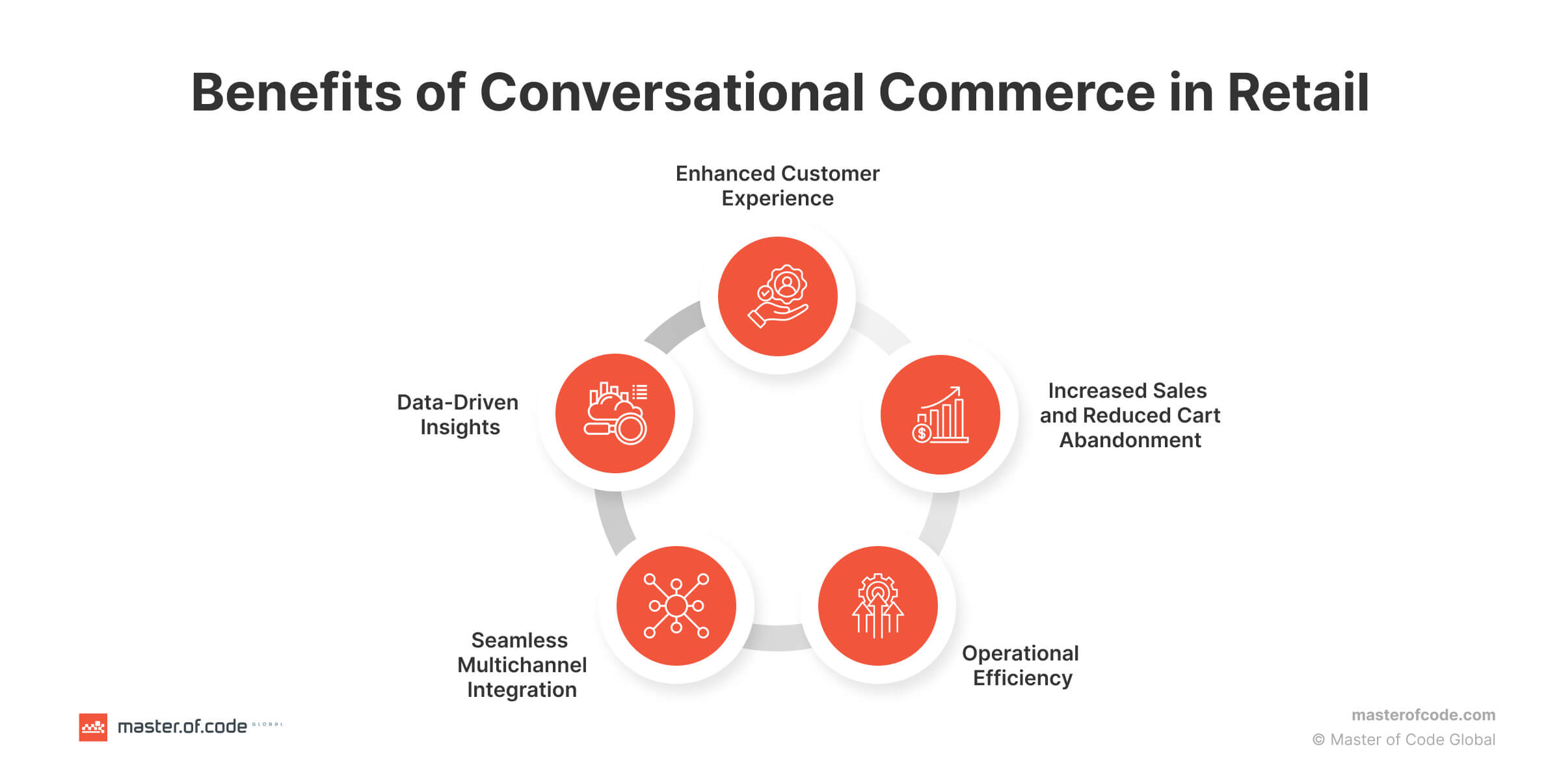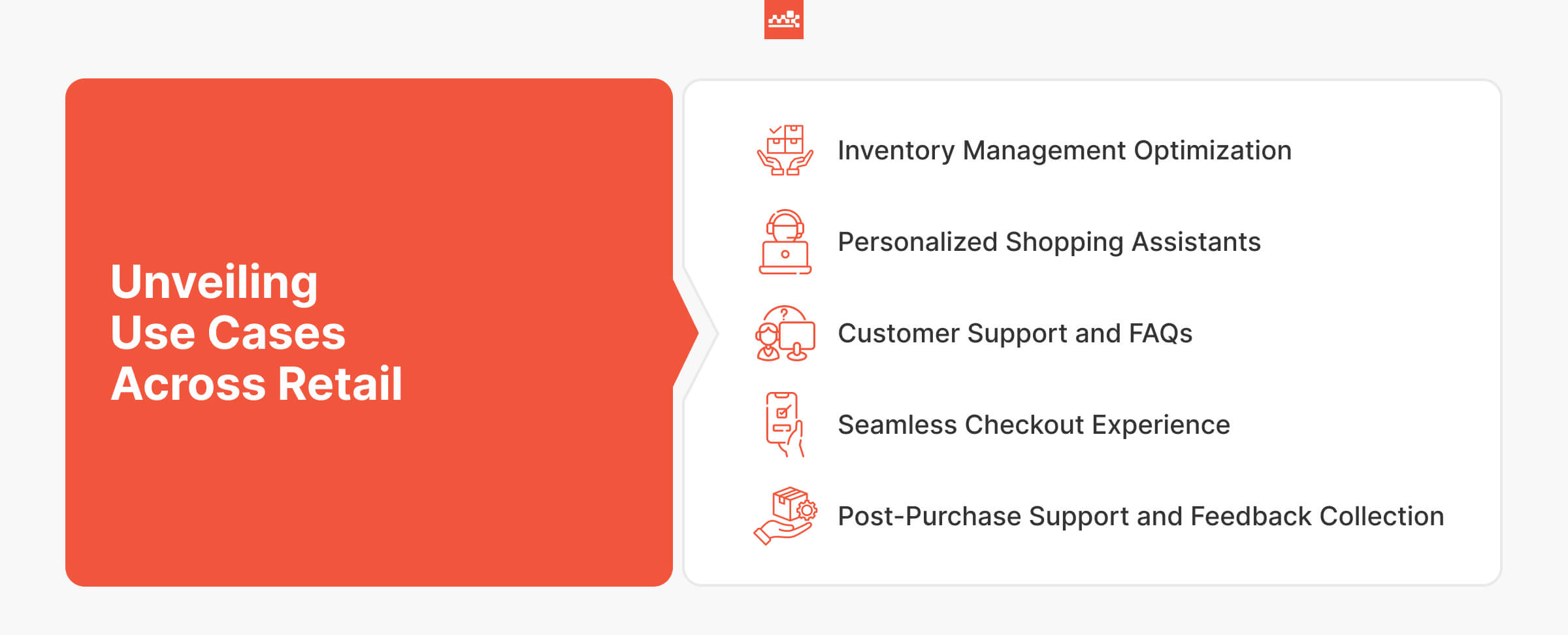In today’s dynamic retail world, the mix of technology and innovative ways buyers engage with brands have led to a big change: conversational commerce. This new way of doing business completely reimagines the customer journey. Companies use tools like messaging apps, chatbots, and voice assistants to make transactions and other user interactions smooth.
Conversational commerce transcends traditional boundaries, enabling personalized, real-time communication that mimics natural dialogs. We can’t overstate its relevance in the retail industry. Conversational channels make online shopping feel more personal. They build trust, make customers happier, and boost sales. Retailers can talk to shoppers online or give them product ideas using voice commands.
The growth trajectory of conversational commerce in retail is remarkable, with projections indicating exponential expansion. As technology evolves, so do consumer expectations, paving the way for exciting trends. For example, over 50% of customers expect a business to be available 24/7. What’s more, adding augmented reality (AR) to shopping gives users a unique experience. They can see what products will look like in their everyday life before a purchase itself. Voice commerce is also gaining traction, offering hands-free convenience in shopping.
Advances in artificial intelligence (AI) keep improving conversational interfaces, making communication more detailed and predictive. With these shifts happening at the same time, conversational commerce is set to change how retail works. It will shape the way businesses interact with customers and help them succeed.
Find practical steps to design effective chatbots for your online store.

Table of Contents
The Rise of Conversational Commerce in the Retail Sector

Customer service has gone through a lot of changes due to conversational commerce. Now more and more people are using chatbots and messaging apps for shopping. This shows that users enjoy talking to businesses via these tools. Between 2023 and 2029, the size of the global conversational commerce market is projected to grow at a CAGR of 24.03% reaching a value of USD 37.64B. This feature helps make everyone’s shopping experience more smooth and pleasant. For example, natural language processing (NLP) enables chatbots and virtual assistants to better understand customers. Moreover, this way chatbots can interact with consumers as real people.
Machine learning algorithms keep making these interactions more effective by learning from each one. This also transforms a regular customer journey into a more personalized and effective one. Also, putting AI-driven chatbots into messaging platforms makes shopping even easier. Clients can buy things right in the chat. These improvements also make customers feel closer to the business and help with upselling. All in all, conversational commerce is changing how retailers focus on experiences shoppers get and bring in new technology.
Benefits of Conversational Commerce in Retail
There are many ways how exactly the retail industry benefits from conversational commerce. In short, it reduces possible difficulties and bottlenecks that people face when they are shopping. A steadily growing number of businesses are now considering conversational AI in retail. According to Statista, worldwide expenditure on conversational commerce channels is projected to reach approximately $290 billion in 2026. Let’s figure out why it is worth all the hassle.

Enhanced Customer Service
Conversational commerce guarantees a top-notch experience for all shoppers worldwide. It provides real-time help, personalized options, and 24/7 client support. Buyers get instant assistance with chatbots and other similar digital solutions. These may be suggestions based on users’ likes and preferences, as well as answers to frequently asked questions. Overall, we can state that such an innovation makes a customer journey more pleasant and successful.
Increased Sales and Reduced Cart Abandonment
Conversational commerce is beneficial for sales, as it significantly reduces cart abandonment. Chatbots and virtual assistants guide customers through the whole buying process. They also answer diverse queries and suggest appropriate products as well as other similar goods to add to the cart. This makes a higher percentage of clients finish their purchases and brings in more money for retailers. The average rate of abandonment during online shopping checkouts is 70.19%, which indicates that 70 out of every 100 potential buyers exit the process without finishing their purchase.
Operational Efficiency
Leveraging AI and chatbots streamlines routine operations, enhancing overall business efficiency. Digital assistants can answer numerous questions, from tracking orders to providing additional product info. This helps human agents focus on more complex or even strategic tasks, making sure the customer service department provides timely assistance and is ROI-positive. This is the way companies can ensure their clients get a smooth and absolutely positive experience.
Seamless Multichannel Integration
Conversational commerce works smoothly across different channels. Customers get the same shopping experience regardless of whether they’re using messaging apps, social media, or websites. It’s possible to start conversations and buy goods without problems, no matter which way users prefer to communicate with your business. By partnering with a trusted service provider, chatbots can be effortlessly integrated with all the channels your company uses for interacting with shoppers.
Data-Driven Insights
With the help of conversational commerce, retailers get a lot of useful information about how clients behave, what they like, and what’s popular. By analyzing interactions, purchase patterns, and feedback, businesses can gain a deeper understanding of their target audience and refine their marketing strategies, product offerings, and customer service initiatives accordingly, driving continuous improvement and innovation.
Conversational commerce helps meet diverse customer expectations, sell more, and make processes run smoother. As technology evolves and buyers are harder to please, using conversational AI solutions will be really important for retailers to succeed in the digital age.
Unveiling Use Cases Across Retail
In the dynamic realm of retail, conversational commerce serves as a game-changer. It offers a lot of applications that streamline operations, ensure seamless round-the-clock support, and drive revenue growth. Nearly 80% of CEOs have changed or intend to change how they manage client engagement using Conversational AI technologies.

Let’s have a look at the main use cases that have changed the way people look at shopping nowadays.
Personalized Shopping Assistants
Chatbots and AI interfaces have already revolutionized the retail landscape by offering individualized shopping experiences. For example, Maybelline’s virtual assistant utilizes AI to recommend makeup products based on customers’ skin tones and preferences. The tool provides tailored suggestions that mimic the expertise of an in-store beauty advisor. Similarly, clothing retailer H&M employs a chatbot that suggests outfit combinations based on clients’ style preferences, sizes, and previous purchases. It helps to deliver a personalized shopping experience that resonates with modern consumers.
Customer Support and FAQs
Conversational commerce plays an important role in delivering efficient customer support and addressing common challenges. By leveraging retail chatbot and virtual assistants, retailers can automate responses to frequently asked questions, for instance, inquiries about shipping, returns, and product availability, freeing up human agents to focus on more complex issues. For example, Amazon’s customer service chatbot handles a vast array of inquiries, ranging from regular order tracking to profound account management. This bot provides prompt and accurate help to millions of consumers worldwide.
Post-Purchase Support and Feedback Collection
Retailers can use chatbots to ease returns, track orders, and gather feedback on product quality and client satisfaction. For instance, furniture retailer IKEA utilizes chatbots to assist buyers with assembly instructions, troubleshoot issues, and collect feedback on their shopping experience. It helps them ensure a seamless post-purchase journey and foster customer loyalty.
Inventory Management Optimization
Conversational commerce in retail offers significant opportunities for optimizing supply chain operations. By integrating AI bots with inventory management systems, retailers can monitor stock levels, track shipments, and receive alerts for low capacity or out-of-stock items. For example, Walmart utilizes chatbots to streamline inventory replenishment processes, enabling real-time communication between suppliers and store managers to ensure optimal product availability and minimize stockouts.
Seamless Checkout Experience
Checkout is really important when you’re shopping, so conversational commerce is here to make it much easier and smoother. Businesses can use chatbots to assist customers through checkout, answer questions, and help with transactions. For example, Domino’s Pizza uses a chatbot for ordering and paying, so customers can conduct all the necessary operations through messages easily.
By harnessing the power of chatbots and AI interfaces, retailers can deliver exceptional customer experiences, streamline operations, and drive business success in an increasingly competitive market. Let’s proceed with exploring the most renowned and successful examples or chatbot implementation from the industry leaders.
Real-World Examples and Case Studies
Several brands have already successfully harnessed the power of conversational commerce in retail. By investing in prominent AI technology, they opened new possibilities for audiences worldwide. Business leaders claim chatbots have increased sales by 67% on average. Let’s check out some of the most famous examples that inspire.
Electronics Retail Chatbot by Master of Code Global
Master of Code Global innovated by crafting a chatbot seamlessly integrated with Shopify, aimed at optimizing the buying journey and amplifying customer contentment. Working hand in hand with our partner, Infobip, the Master of Code Global team engineered an advanced Apple Messages for Business chatbot.
This sophisticated tool not only facilitates smoother interactions with customers but also serves as a catalyst for increasing sales and elevating the overall purchasing experience. Through this strategic partnership and cutting-edge technology, companies can revolutionize their client engagement strategies and set new standards for consumer satisfaction.
BloomsyBox
Master of Code Global, in collaboration with Infobip, pioneered the creation of a groundbreaking Generative AI chatbot tailored for crafting personalized greeting cards. Leveraging our cutting-edge LLM Orchestration Framework (LOFT), we seamlessly integrated a Generative AI component.
This innovative solution empowers recipients to craft custom messages for their close people, spanning a spectrum from light-hearted and amusing to deeply heartfelt and affectionate. By harnessing the power of AI in this unique way, we enabled individuals to express their sentiments in a truly unique manner, revolutionizing the concept of personalized communication and enhancing the emotional connection between sender and recipient.
Starbucks
The first example is Starbucks, which introduced its virtual assistant, “Barista”, on their mobile app. Through this chatbot, clients can place orders, customize drinks, and make payments seamlessly. The tool enhances convenience and expedites the whole ordering process. Starbucks’ innovative use of conversational commerce has not only boosted sales but also deepened customer loyalty by providing a personalized and frictionless experience.
Sephora
Another compelling case study is Sephora, a global cosmetics retailer that leverages chatbots to offer personalized beauty advice and product recommendations. Sephora’s virtual assistant utilizes AI to analyze clients’ skincare concerns, preferences, and purchase history to provide tailored product suggestions and home routines. This personalized approach has significantly enhanced the customer experience, driving sales and fostering brand devotion among Sephora’s diverse customer base.
ASOS
Clothing retailer ASOS has a chatbot on Facebook Messenger to help buyers with shopping and selecting goods. The chatbot gives advice on finding products, figuring out sizes, and getting ideas, like a personal online stylist. ASOS uses AI-driven chatbots to elevate their customer service, and this way makes clients more willing to keep shopping with the brand.
Challenges and Considerations
As businesses embrace conversational commerce to enhance customer engagement and drive sales, they must navigate various challenges inherent in this evolving landscape. One such aspect is privacy concerns surrounding the collection and use of customer data. Retailers must prioritize security and transparency to build trust with their clients and ensure compliance with privacy regulations such as GDPR and CCPA.

Lack of Humanization
Moreover, achieving human-like interactions through chatbots and virtual assistants poses another significant challenge. AI technology has advanced considerably, yet replicating the nuances of human conversation remains a complex task. Retailers must invest in natural language processing (NLP) and machine learning algorithms to ensure that their conversational interfaces can understand and respond to customer inquiries accurately and empathetically.
Commitment to Flexibility
The need for continuous improvement based on customer feedback is essential for the success of conversational commerce initiatives. Retailers must actively solicit feedback from clients and iterate on their conversational interfaces to address pain points and enhance the overall user experience. This iterative approach requires a commitment to agility and flexibility, as well as a willingness to adapt to changing user preferences and market trends.
Keeping Consistency
Additionally, integrating conversational commerce seamlessly across various channels and touchpoints presents another challenge for retailers. Consistency in branding, messaging, and user experience is critical to delivering a cohesive omnichannel experience for buyers. Retailers must invest in robust platforms and technologies to ensure that their conversational interfaces align with the broader marketing and customer engagement strategies.
Navigating the complexities of conversational commerce in retail presents its hurdles, yet with the right ally, these challenges become insignificant. Partnering with Master of Code unlocks a world of expertise and innovation, ensuring seamless integration of conversational solutions into your retail ecosystem. With our proven track record and forward-thinking approach, our team empowers you to revolutionize the retail experience and drive unparalleled growth.
Conclusion
Conversational commerce in retail has emerged as a transformative force in the retail industry, reshaping how businesses engage with customers. This new approach helps them drive success in a changing digital world.
From personalized shopping assistants to seamless checkout experiences, the possibilities are limitless when it comes to leveraging chatbots and AI-driven interfaces to enhance customer engagement and drive sales. Real-world examples from leading retailers illustrate the tangible impact of conversational commerce on improving the client experience and fostering brand loyalty.
As businesses navigate the complexities of implementing AI solutions, it’s essential to prioritize data privacy, strive for human-like interactions, and embrace continuous improvement based on customer feedback. By doing so, retailers can unlock the full potential of conversational commerce to deliver exceptional experiences and stay ahead in a competitive market.
Ready to build your own Conversational AI solution? Let’s chat!






